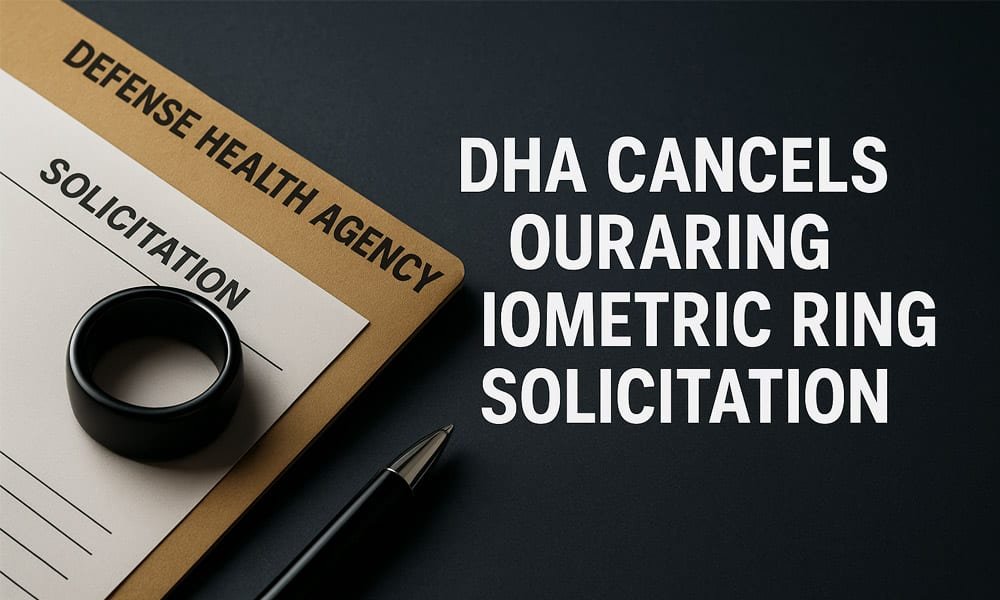News
DHA Cancels OuraRing Biometric Ring Solicitation: What Really Happened?
Published
3 months agoon
By
Archie
In March 2025, the U.S. Defense Health Agency (DHA) surprised many people by canceling its $96 million contract for Oura smart rings. These small rings, made by Oura Health, were supposed to help track the health and wellness of military medical staff. The news of this cancellation raised many questions. Why was the plan dropped? What went wrong with the deal? And what does this mean for the future of wearable health tech in the military?
In today’s article, we will take a closer look at everything that happened. We will explore what the OuraRing contract was all about, why DHA wanted these rings, and how the situation turned into a big controversy. We will also look at the protests from WHOOP, another wearable company, and why DHA decided to walk away from the plan. Let’s start by understanding the basics of this canceled contract.
What Was the OuraRing Contract About?
The OuraRing contract was a huge deal worth around $96 million. It was announced in August 2024 when DHA decided to bring wearable tech into military healthcare. The idea was simple but powerful: give medical workers a tool that tracks their health in real time. This would help them perform better under stress and avoid burnout.
Oura smart rings are small but packed with advanced sensors. They track heart rate, body temperature, sleep quality, and even stress levels. DHA believed that this kind of data could help military doctors and nurses stay healthier and stronger while handling tough jobs. Imagine being able to see if you’re too tired or stressed before it affects your work — that’s the kind of insight these rings were supposed to give.
This contract wasn’t just about buying gadgets. It also included a wellness platform that would collect the data and offer personalized tips. For example, the system could recommend better sleep habits or help users manage stress. On paper, this plan looked like a smart step toward a healthier and more prepared medical team.
Why DHA Wanted Oura Rings
The military has always been interested in tools that improve performance. In recent years, wearable tech has become very popular, and Oura Rings stand out because they are small, accurate, and easy to wear. Unlike big fitness watches, these rings don’t get in the way of work, which is perfect for busy medical staff.
DHA wanted these rings to help reduce fatigue and monitor health in real time. For example, if a nurse is showing signs of extreme tiredness, the system could alert them to take a break or rest properly. This kind of proactive health care is very important in high-stress environments like military hospitals.
Another reason was mental well-being. The Oura platform offers stress tracking, and this was meant to help workers handle tough schedules without burning out. DHA saw it as an investment in both physical and mental health. Many experts agreed that wearable data could be a game-changer in keeping medical teams safe and efficient.
The Big Announcement of the Deal
When DHA first announced the OuraRing contract, it made headlines. A $96 million deal for health rings was big news, and many people were curious to see how this project would work. The idea of using wearable tech in the military sounded modern and forward-thinking.
However, not everyone was happy. Soon after the announcement, some companies and industry experts started asking questions. Why did DHA choose only Oura for such a huge deal? Were other companies even given a chance to compete? These questions slowly turned the spotlight on how the contract was awarded.
The fact that this was a sole-source deal — meaning DHA only talked to Oura and no other company — raised eyebrows. In government contracts, competition is usually encouraged to get the best value. This was the start of the controversy.
The Start of Controversy
The main reason for the backlash was that the contract seemed designed just for Oura. The requirements were so specific — especially the demand for a “ring” form factor — that no other company could realistically apply. This was seen as unfair and possibly even biased.
One company that quickly raised its voice was WHOOP, a popular maker of fitness bands. They argued that their wearable devices could do the same job, if not better, than Oura’s rings. The issue wasn’t about the technology itself but about the lack of open competition. WHOOP believed the rules should be fair and allow more than one company to prove their worth.
As the controversy grew, DHA started facing pressure from different sides. Critics argued that limiting the contract to rings alone was unnecessary and left out a lot of potential innovation. This pushed the situation toward formal protests.
WHOOP Steps In
WHOOP is known for its high-tech fitness bands that track detailed health data. When they saw the OuraRing contract, they felt strongly that they could provide a similar or even better solution. But because DHA’s contract only allowed “rings,” WHOOP had no chance to participate.
In October 2024, WHOOP filed its first protest with the Government Accountability Office (GAO). They argued that the sole-source deal with Oura was not fair and blocked competition. Their protest forced DHA to cancel the first version of the contract and reconsider its plans.
At this point, it looked like DHA might open the door to more vendors. But what happened next only made things more complicated.
Second Round of Problems
After the first protest, DHA tried again. They issued a new request for proposals, but once again, the requirement for a “ring-based” wearable was included. This meant that, once again, Oura was the only company that could meet the requirements.
Not surprisingly, WHOOP filed a second protest in January 2025. This time, the protests were even louder, and the media began covering the issue in detail. WHOOP claimed that DHA’s approach excluded 97% of wearable tech companies, as most health wearables are watches or bands, not rings.
This second round of protests made the situation much bigger. Lawmakers and government officials started asking questions about why DHA was sticking to such a narrow requirement. The pressure was building, and everyone was waiting to see what DHA would do next.
Why DHA Finally Canceled the Deal
After weeks of pressure, DHA decided to end the OuraRing contract. On March 5, 2025, the agency sent an official note saying the project was “no longer required” and “not a priority.” These simple words ended what could have been one of the biggest wearable tech deals for the military.
Why did they cancel it? One reason was the ongoing protests from WHOOP and other voices calling for fair competition. Another reason was the cost. Spending $96 million on smart rings seemed too much when the Pentagon was cutting budgets. By early 2025, the government was rethinking where money should go, and the OuraRing plan no longer fit the top list of needs.
The timing of leadership changes also played a role. Lt. Gen. Telita Crossland, who was leading DHA, left her post suddenly. With new leaders and different priorities, the OuraRing contract didn’t have the same support as before.
Political and Budget Pressure
The U.S. defense budget in 2025 has faced many cuts and reshuffles. The new Secretary of Defense, Pete Hegseth, focused on other programs that were seen as more urgent, such as border security and advanced weapons. In this climate, spending millions on wearable rings was not a top priority.
Lawmakers also started to question why DHA was giving such a big contract to one company without open competition. Some said it looked like favoritism, which made the issue even more political. When both money and politics are against a project, it’s hard for it to survive.
Think of it like a company deciding to cut back on perks when business is slow. Even if the perk is useful, it’s often the first thing to go. That’s what happened here. The OuraRing project was seen as helpful but not essential.
What This Means for Oura
For Oura Health, the cancellation was a huge setback. A $96 million contract would have been a major win and a big boost for the company’s reputation. Without this deal, Oura will continue to focus on regular consumers and smaller partnerships.
Still, Oura is a strong brand with millions of users worldwide. While losing a government contract is tough, it doesn’t mean the company is done with big opportunities. Oura might return in future military projects if new plans are made with fair competition.
It’s also worth noting that the controversy itself gave Oura a lot of attention. Even though the contract didn’t happen, people now know more about the company and what its rings can do.
WHOOP’s Reaction and Win
WHOOP celebrated the news of DHA’s cancellation. For them, it was proof that the protests worked. WHOOP argued from the start that the deal was unfair, and the cancellation felt like a victory for open competition.
The company publicly thanked the Department of Defense for reconsidering the contract. WHOOP also said it hopes future plans will allow more companies to compete. This could open doors not just for WHOOP but for other wearable tech makers.
It’s a reminder that standing up for fairness can make a difference. WHOOP’s protests may have been a headache for DHA, but they also forced the agency to rethink its choices.
Lessons Learned from This Case
The story of the DHA and OuraRing contract teaches a few clear lessons. First, government contracts need to be fair and open. When a deal is limited to just one vendor, it raises questions and invites protests.
Second, budget priorities can change very quickly. Even a project that looks important one month can be cut the next if leaders decide to spend money elsewhere. This is especially true for big organizations like the military.
Lastly, it shows that wearable tech is becoming a serious player in health and performance. Even though this deal failed, the interest in using wearables for better health monitoring is not going away.
What Could Happen Next?
What’s next for DHA? Right now, there is no new plan to replace the OuraRing contract. But the need for health monitoring tools is still there. Military doctors and nurses face long hours and high stress, and technology can help manage that.
If DHA tries again, the new plan might be more open. Instead of focusing only on rings, they could allow watches, bands, or even patches. This would give companies like WHOOP, Fitbit, and Apple a chance to compete.
The wearable tech market is growing fast in 2025. It would not be surprising if we see a new, bigger project in the future — but this time with more fairness and better competition.
Conclusion
The cancellation of the OuraRing biometric ring solicitation by DHA is a story of change, protest, and shifting priorities. What started as a big step toward modern healthcare for military workers ended with a quiet but clear decision: the project is not moving forward.
For Oura, it was a missed chance, but for WHOOP, it was a small victory. For DHA, it was a lesson in transparency, fair bidding, and managing budgets. Even though the contract is gone, the idea of using wearable tech for health and wellness is still alive and strong.
In the future, we might see new projects that build on this idea, but with better planning and fair rules. For now, the OuraRing deal will be remembered as a bold plan that didn’t go as expected.
Other articles you may read:
You may like

How Local Couriers Support Small Businesses

Best Replica YSL Bag in Patent Leather

Put Pen to Paper: How Custom Notebooks Can Make a Lasting Impression

From Listing to Sold: Sell A Car in Perth Without the Stress

Unlocking the Benefits of Engineered Steel Solutions for Modern Construction

Discover the Ultimate Comfort and Style of Women’s Underwear in Australia

Unlocking Performance: The Ultimate Guide to Custom PC Builds with Centre Com

Unlocking Opportunities in General Practice Recruitment: A Guide by Global Medics

Hope & Kent: How Snow Removal Technology Is Reaching B.C.’s Most Challenging Terrains

Connecting the Dots in Recruitment: How Skima AI Integrates Seamlessly with Your Hiring Stack

Carol Kirkwood’s Journey: Her Real Age, Husband, Career, and More

Revolutionizing Healthcare: The Emergence of AI-Driven Analytics

How Machine Learning and AI are Redefining the Future?

Aliza Barber: Meet Lance Barber’s Wife, Age, Life, Profile, Career and Net Worth

Evelyn Melendez: Jordan Knight’s Wife Bio, Marriage, Family, Career and Net Worth

Ilan Tobianah Biography: Family, Marriage, Lifestyle, Career and Net Worth

Who was Alice Marrow? Everything to Know About Ice-T’s and His Mother

King Von’s Autopsy Report: The Truth Behind the Tragic Death

Meet Otelia Cox: The Supportive Wife of Tony Cox – A True Fairy Tale Romance

Tea Leoni and Tim Daly Split – A Closer Look at Their Relationship and Breakup

How Local Couriers Support Small Businesses

Best Replica YSL Bag in Patent Leather

Put Pen to Paper: How Custom Notebooks Can Make a Lasting Impression

From Listing to Sold: Sell A Car in Perth Without the Stress

Unlocking the Benefits of Engineered Steel Solutions for Modern Construction

Discover the Ultimate Comfort and Style of Women’s Underwear in Australia

Unlocking Performance: The Ultimate Guide to Custom PC Builds with Centre Com

Unlocking Opportunities in General Practice Recruitment: A Guide by Global Medics

Hope & Kent: How Snow Removal Technology Is Reaching B.C.’s Most Challenging Terrains

Connecting the Dots in Recruitment: How Skima AI Integrates Seamlessly with Your Hiring Stack
Category
Trending
-

 News2 months ago
News2 months agoCarol Kirkwood’s Journey: Her Real Age, Husband, Career, and More
-

 Health2 years ago
Health2 years agoRevolutionizing Healthcare: The Emergence of AI-Driven Analytics
-

 Technology2 years ago
Technology2 years agoHow Machine Learning and AI are Redefining the Future?
-

 Celebrity1 year ago
Celebrity1 year agoAliza Barber: Meet Lance Barber’s Wife, Age, Life, Profile, Career and Net Worth
